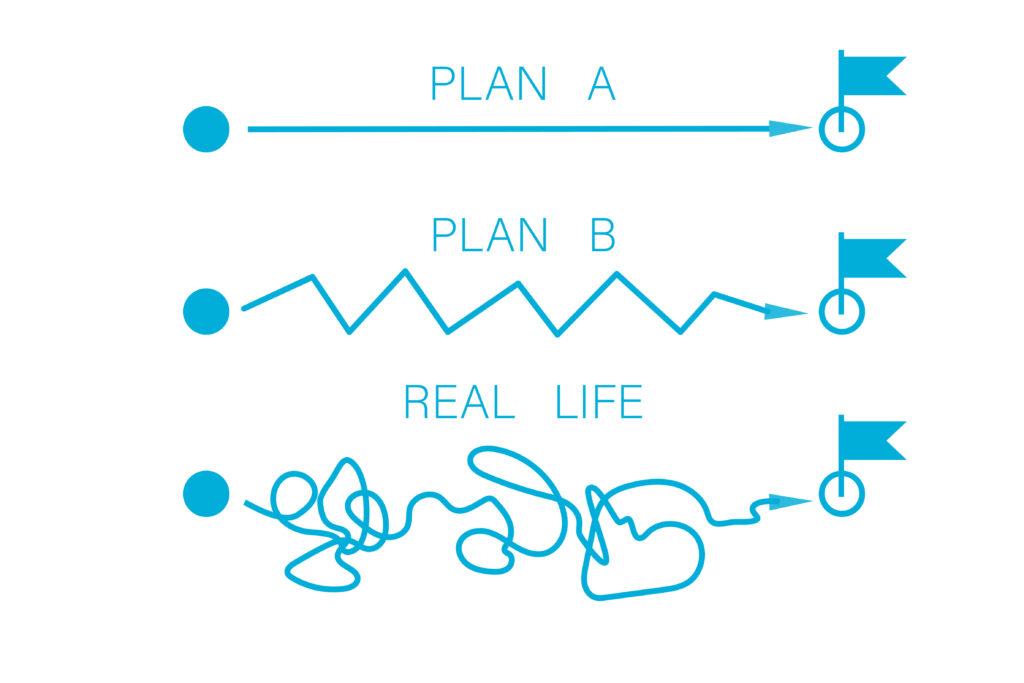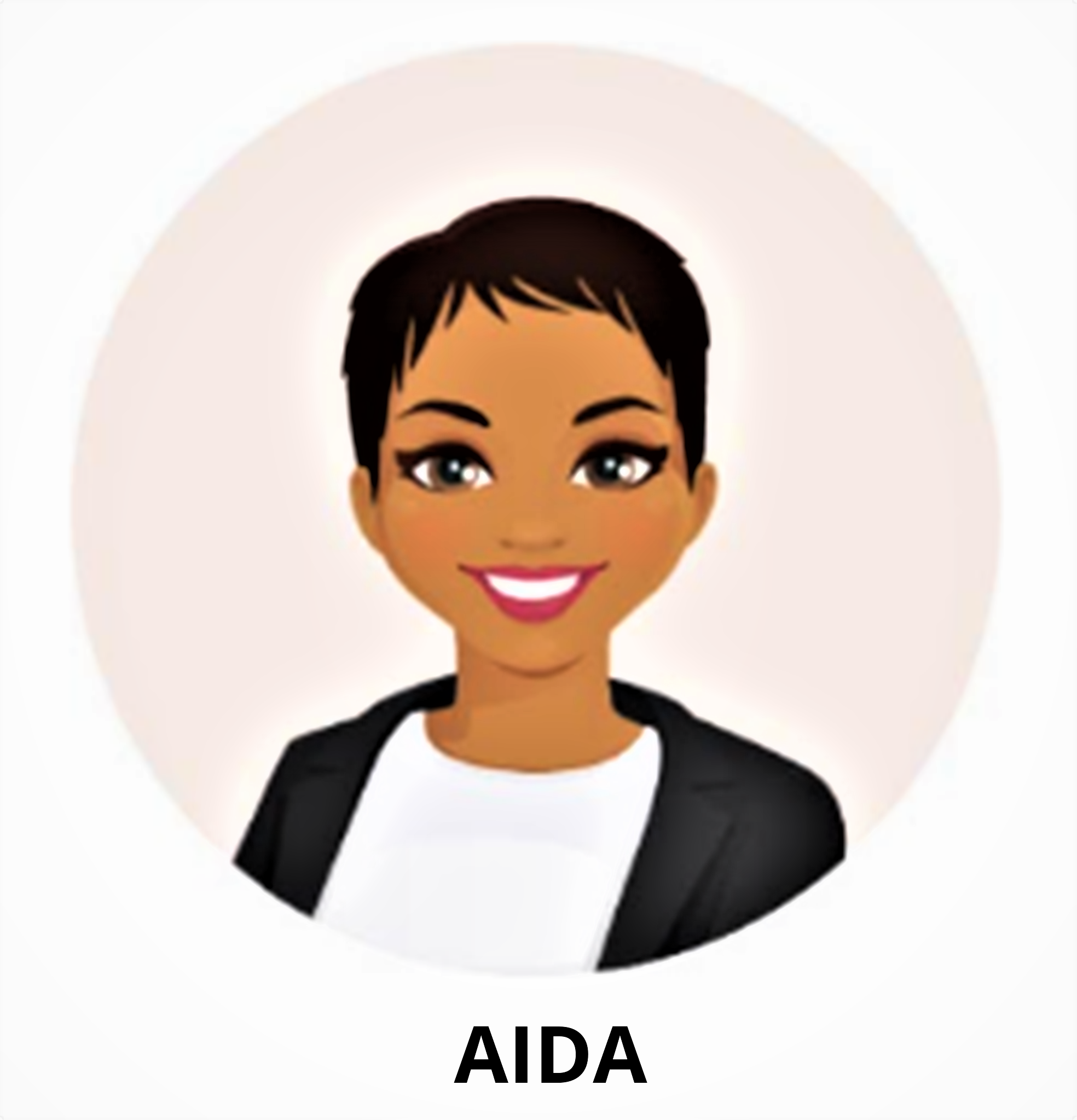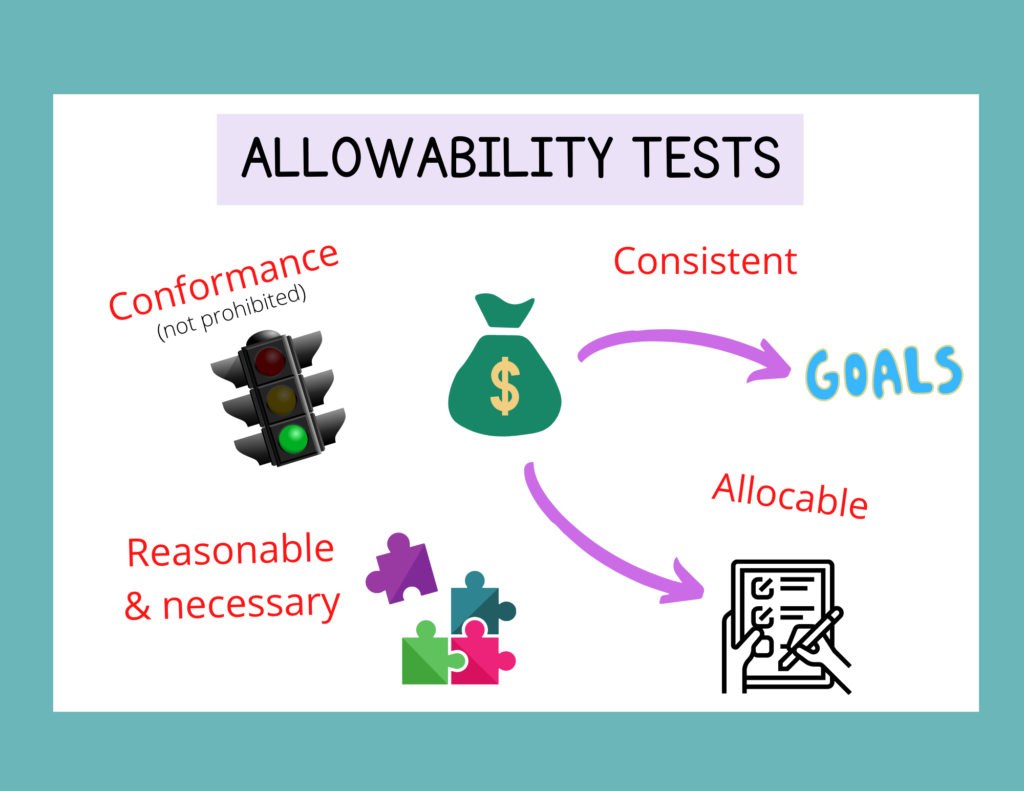Archives: Lessons
Lesson 2: The Four Tests
Reference – 45 CFR 75; §75.403 Factors affecting allowability of costs
Let us turn our attention to the four tests used in determining the allowability of costs. This is important because proper use of federal funds is required by law. As a recipient of federal funds, you are responsible for knowing the requirements, and if you serve as a pass-through entity, you are also responsible for ensuring any sub-recipient is aware of the requirements. Another key factor is the responsibility for monitoring the use of funds to determine if budget expenditures are allowable, allocable, reasonable, and consistent.
How budget expenditures are determined
- Allowable (Conformance): Expenditure is permitted and not specifically prohibited
- Allocable: Traceable to specific activities of the grant project
- Reasonable: Cost that would be incurred by a prudent person; necessary for the grant’s performance
- Consistent: Assignment of costs to cost objectives
Click on the first topic below to continue
Resources
Supported Decision-Making in Practice
The National Resource Center for Supported Decision-Making is a federal project supported supported decision-making. Their website contains multiple stories about supported decision-making: http://www.supporteddecisionmaking.org/impact.
Explore this resource now before continuing on to the think spot below.
Kentucky and Supported Decision-Making
Kentucky has not adopted SDM into guardianship law. SDM has been included in proposed guardianship legislation and is awaiting the approval of the General Assembly.
My Choice Kentucky is a collaboration with the University of Kentucky Human Development Institute and KY Protection and Advocacy to look at alternatives to guardianship. My Choice Kentucky also provides resources and training on supported decision-making: https://mychoiceky.org
The model has also been discussed in Kentucky Working Interdisciplinary Networks of Guardianship Stakeholders (WINGS) meetings as a viable option for guardianship.
National Resource Center for Supported Decision-Making story – Freed From Guardianship A Kentucky First: Suzie Wins Her Rights in Court Using SDM – https://supporteddecisionmaking.org/stories/suzanne-heck/
National Guardianship Association Position
The National Guardianship Association (NGA) supports ongoing research to determine the effectiveness of supported decision-making models as alternatives to guardianship.
Guardianship should be utilized only when less restrictive supports are not available. Alternatives to guardianship, including supported decision-making, should always be identified and considered whenever possible before the start of guardianship proceedings.
The NGA position statement also says,

“Under all circumstances, efforts should be made to encourage every person under guardianship to exercise his/her individual rights retained and participate, to the maximum extent of the person’s abilities, in all decisions that affect him or her, to act on his or her own behalf in all matters in which the person is able to do so, and to develop or regain his or her own capacity to the maximum extent possible.”
Reference:
Position Statement on Guardianship, Surrogate Decision-Making and Supported Decision-Making https://www.guardianship.org/advocacy/position-statements
Other Alternatives to Guardianship
How Does Supported Decision-Making Support Dignity of Risk?

Ronnie says, “The term “dignity of risk” was created in the 1970s around issues of care for people with intellectual disabilities.”
People with intellectual or developmental disabilities were often viewed as incapable of living independently or making decisions for themselves – a view that often deprived them of many typical life experiences that others take for granted.

Ronnie pulls up another video, “This is Max Burrow, a person with a disability who works as a self-advocate for people with disabilities. This is a great overview of why dignity of risk is important.”

Dignity of risk acknowledges that life experiences come with risk, and that we must support people in experiencing success and failure throughout their lives. SDM is a process that supports and preserves dignity of risk.
What Does Supported Decision-Making Look Like?

Ronnie tells you, “Supported decision-making will look different for everyone. It means finding tools and supports to help a person with a disability understand, make, and communicate their own choices.”
Examples of these tools might be:
- Plain language materials or information in visual or audio form.
- Extra time to discuss choices.
- Creating lists of pros and cons.
- Role-playing activities to help the person understand choices.
- Bringing a supporter into important appointments to take notes and help the person remember and discuss their options.
- Opening a joint bank account to make financial decisions together.


“Here is another example of what supported decision-making looks like,” Ronnie says. “Let’s watch this video of Clayton.”
Course Evaluation
DAIL-G 102: Supported Decision-Making and Other Alternatives to Guardianship
Course Wrap Up

Congratulations! You have completed DAIL-G 114: Communication and Coping When an Individual Under Guardianship Passes Away. Please note that your supervisor may have follow-up questions or need more information. Please respond to any requests promptly.
Once you click “mark complete,” a certificate of completion will be available to you. You may print or download your certificate to verify the completion of DAIL-G 114: Communication and Coping When an Individual Under Guardianship Passes Away. This certificate will also be available at the beginning of the course anytime you log on.
Click the “Mark Complete” button below to access your certificate of completion.
Resources Example Copy
Have questions or need help with Universal Precautions? DAIL has nurse consultants available to provide resources, answer questions, and provide assistance.
Handouts
Handwashing and Hand Sanitizer Use
Cover your Cough
Lesson Example Copy
Handwashing is one of the most important ways to prevent the spread of disease. It is important to use soap and water and wash your hands for at least 30 seconds or the time it takes to sing the ABC’s.
Hands should be washed:
Example Accordion
Description for this block. Use this space for describing your block. Any text will do. Description for this block. You can use this space for describing your block. Description for this block. Use this space for describing your block. Any text will do. Description for this block. You can use this space for describing your block.
Example Accordion
Description for this block. Use this space for describing your block. Any text will do. Description for this block. You can use this space for describing your block. Description for this block. Use this space for describing your block. Any text will do. Description for this block. You can use this space for describing your block.
What You Need To Know About Handwashing

Simon tells you, “I never knew how important handwashing was until I watched this video. It’s gross to see how many germs stay on our skin.”
Watch this video for more information about how and why hands should be washed. The entire video must be watched before being able to move on.
[ld_video]
Think Spot: Handwashing
Welcome

Hi, I am Simon. While it is never pleasant to think about, individuals we work with will pass away. It is important for us to understand how to cope with the loss of an individual under guardianship while following related policies and procedures.
Course Goals
This training course is designed to provide an overview of the basics of what to do in the event that an individual under guardianship passes away.
| Learning Goal #1: Identify and use coping strategies to help support DAIL Guardianship staff. | |
| Learning Goal #2: Describe ways to communicate with family before and after an individual passes. |
Start Here – Contact Us
Select the accessibility widget on the right hand of the screen to access features such as:

Screen Reader: Reads content on the page.
Contrast Adjuster: Adjust color to meet your individual needs.
Text Magnifier: Adjust the size of text on the page to make reading easier.
And more!
Need Help?
Use one of the contact buttons below to get assistance.
Course Content
For help with course content reach out to Jessica Wayne.
Technical Assistance
For help with HDI Learning and issues with the website, please use the “Contact Us” button.
Course Wrap Up

Congratulations! You have completed DAIL-G 113: Safety Awareness! Please note that your supervisor may have follow-up questions or need more information. Please respond to any requests promptly.
Once you click “mark complete,” a certificate of completion will be available to you. You may print or download your certificate to verify the completion of DAIL-G 113: Safety Awareness. This certificate will also be available at the beginning of the course anytime you log on.
Reminder from Aida

This course is part of a series of trainings required for all new employees. All new hires are required to satisfactorily complete trainings before being assigned cases.
All courses must be completed in order and in a timely manner.
This includes DAIL:
Click the “Mark Complete” button below to access your certificate of completion.
Information Sources
Lesson Example Copy
Handwashing is one of the most important ways to prevent the spread of disease. It is important to use soap and water and wash your hands for at least 30 seconds or the time it takes to sing the ABC’s.
Hands should be washed:
Example Accordion
Description for this block. Use this space for describing your block. Any text will do. Description for this block. You can use this space for describing your block. Description for this block. Use this space for describing your block. Any text will do. Description for this block. You can use this space for describing your block.
Example Accordion
Description for this block. Use this space for describing your block. Any text will do. Description for this block. You can use this space for describing your block. Description for this block. Use this space for describing your block. Any text will do. Description for this block. You can use this space for describing your block.
What You Need To Know About Handwashing

Simon tells you, “I never knew how important handwashing was until I watched this video. It’s gross to see how many germs stay on our skin.”
Watch this video for more information about how and why hands should be washed. The entire video must be watched before being able to move on.
[ld_video]
Think Spot: Handwashing
Welcome
Course Goals
This training course is designed to provide an overview of the basics of:
| Learning Goal #1 Identify safety procedures to follow before, during, and after a home visit. | |
| Learning Goal #2 List steps to take in the event of an emergency or accident. |
Start Here – Contact Us
Select the accessibility widget on the right hand of the screen to access features such as:

Screen Reader: Reads content on the page.
Contrast Adjuster: Adjust color to meet your individual needs.
Text Magnifier: Adjust the size of text on the page to make reading easier.
And more!
Need Help?
Use one of the contact buttons below to get assistance.
Course Content
For help with course content reach out to Jessica Wayne.
Technical Assistance
For help with HDI Learning and issues with the website, please use the “Contact Us” button.





